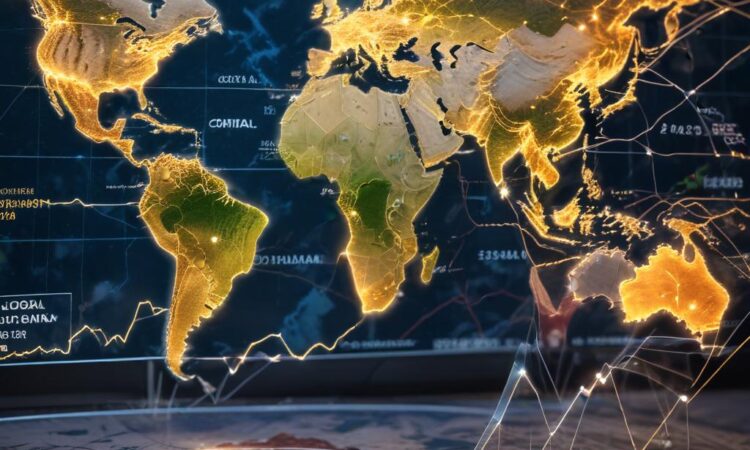Global Inflation and Central Bank Actions: Navigating a Complex Economic Landscape
The global economy continues to grapple with the ramifications of persistent inflation, prompting central banks worldwide to adjust their monetary policies in an attempt to curb price pressures and maintain economic stability. This report examines the latest inflation data and central bank decisions on interest rates and monetary policy in major economies like the United States, Europe, and China, analyzing their impact on global markets and economic growth.
United States: A Battle Against Inflation
The Federal Reserve (Fed) has been aggressively raising interest rates since early 2022 to combat inflation, which has been driven by a combination of factors, including supply chain disruptions, strong consumer demand, and the lingering effects of the COVID-19 pandemic. The Fed’s target federal funds rate has risen from near zero to a range of 5.25% to 5.5%, marking the most aggressive tightening cycle in decades.
The latest inflation figures, as measured by the Consumer Price Index (CPI), have shown a moderation in the rate of price increases. However, core inflation, which excludes volatile food and energy prices, remains stubbornly high, indicating underlying inflationary pressures. The Fed is closely monitoring these trends, and further interest rate hikes remain a possibility if inflation fails to decline as expected.
The impact of the Fed’s actions on the US economy is complex and multifaceted. While higher interest rates aim to cool demand and reduce inflation, they also carry the risk of slowing economic growth and potentially triggering a recession. The labor market, a key indicator of economic health, has shown some signs of softening, with job growth slowing and unemployment edging up. The Fed is navigating a delicate balancing act, seeking to tame inflation without causing undue harm to the economy.
Europe: Inflationary Pressures and Monetary Policy Challenges
The European Central Bank (ECB) has also been tightening monetary policy in response to elevated inflation rates. The ECB has raised interest rates by a total of 4.25 percentage points since July 2022, bringing the deposit rate to 3.75%. The Eurozone has faced a unique set of challenges, including the energy crisis stemming from the war in Ukraine, which has exacerbated inflationary pressures.
While inflation in the Eurozone has begun to moderate, it remains well above the ECB’s 2% target. The ECB is committed to bringing inflation back to its target level, but it faces a number of headwinds, including the ongoing geopolitical uncertainty and the possibility of a recession.
The ECB’s monetary policy decisions have had a mixed impact on the Eurozone economy. While some sectors have benefited from stronger consumer spending, others have been negatively affected by higher borrowing costs. The ECB’s focus on maintaining price stability comes at a time when the Eurozone economy is already showing signs of weakness.
China: Managing Inflation and Supporting Growth
China, the world’s second-largest economy, has experienced a period of relatively low inflation in recent years. However, the country faces a unique set of economic challenges, including a slowing property sector, weak consumer demand, and the ongoing impact of the COVID-19 pandemic.
The People’s Bank of China (PBOC) has adopted a more accommodative monetary policy to support economic growth. Interest rates have been lowered, and the PBOC has eased lending requirements to encourage investment and consumption. The PBOC’s primary goal is to maintain stability in the financial system and prevent a sharp economic slowdown.
China’s economic outlook remains uncertain, with inflation expected to remain relatively subdued in the short term. The PBOC’s policy stance will continue to be influenced by the country’s economic performance and the global economic environment.
The Global Impact of Central Bank Actions
The coordinated efforts of central banks to combat inflation have had a significant impact on global markets. Rising interest rates have led to increased borrowing costs for businesses and individuals, potentially slowing economic activity. Currency valuations have also been affected, with the US dollar strengthening against other major currencies.
The global economy is interconnected, and central bank actions in one region can have ripple effects across the world. As central banks continue to navigate the complex landscape of inflation and economic growth, their decisions will have a profound impact on global markets and the lives of people around the world.
Looking Ahead: Uncertainty and Challenges
The path ahead for the global economy remains uncertain. Inflationary pressures remain elevated in many economies, and the threat of recession looms large. Central banks are facing a delicate balancing act, seeking to tame inflation without causing undue economic harm.
The ongoing geopolitical uncertainty, including the war in Ukraine and rising tensions between major powers, adds to the complexities of the economic outlook. The ability of central banks to effectively manage inflation and support economic growth will be crucial in determining the future trajectory of the global economy.
This report provides a snapshot of the current economic landscape and the actions of central banks around the world. As inflation and monetary policy continue to evolve, it is essential to stay informed and monitor developments closely.
Conclusion
The global economy is grappling with a complex set of economic challenges, including persistent inflation and the threat of recession. Central banks around the world are actively adjusting their monetary policies in an attempt to curb price pressures and maintain stability. The decisions made by central banks will have a significant impact on global markets and economic growth.
It is crucial to monitor developments closely and understand the implications of central bank actions for businesses, investors, and individuals.

